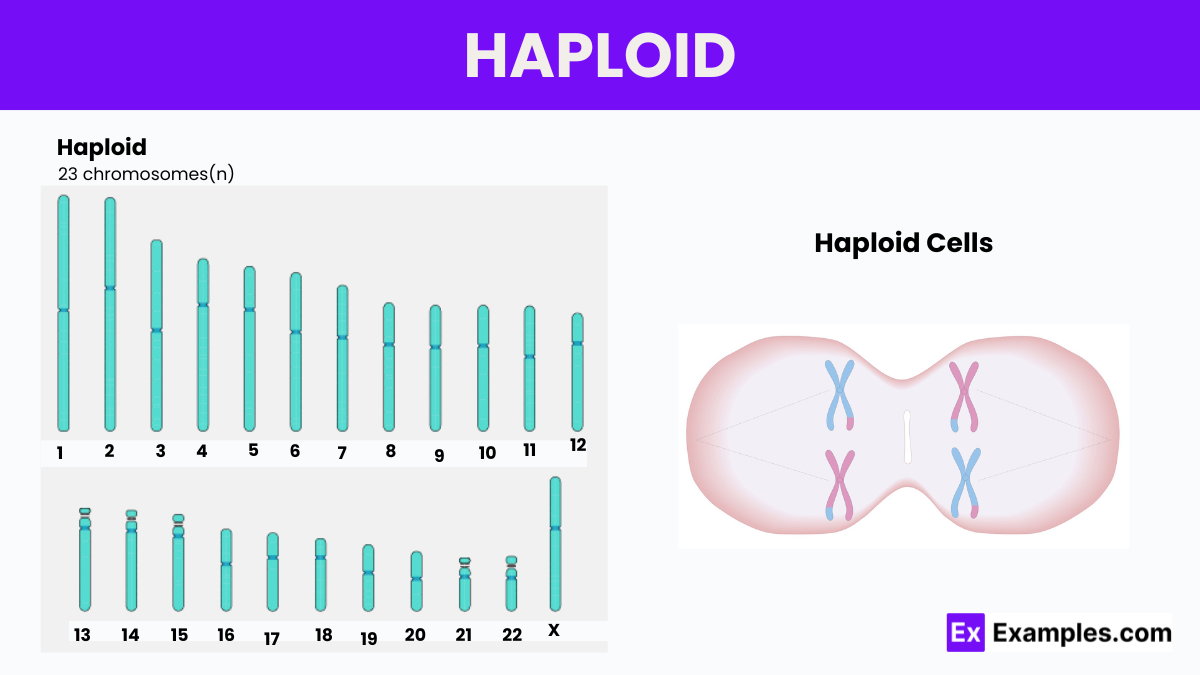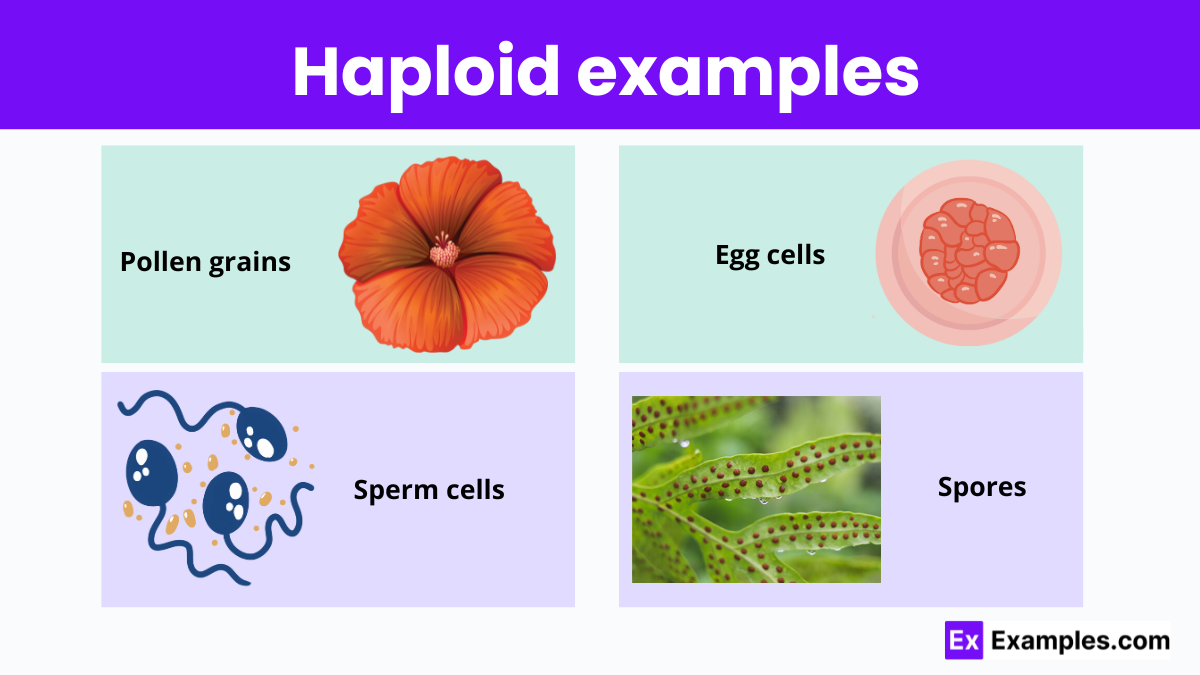What does the term "haploid" refer to in biology?
A cell with a complete set of chromosomes
A cell with half the number of chromosomes
A cell with extra chromosomes
A cell with no chromosomes


Haploid cells contain a single set of chromosomes, typically found in gametes like sperm and egg cells in humans, where each carries 23 chromosomes. This count, represented as n, is crucial for maintaining genetic stability during reproduction. Haploid cells are produced through meiosis, a cell division process that halves the chromosome number from diploid parent cells. Besides human reproduction, some organisms, such as certain algae and male bees, exhibit haploidy in their life cycles, emphasizing its importance in genetics.
A haploid cell is one that contains a single set of chromosomes, half the number found in normal body cells, and is essential for sexual reproduction. Common examples of haploid cells are human sperm and egg cells, each with 23 chromosomes.
Haploid cells contain only one set of chromosomes, half the number found in diploid cells, and are crucial for sexual reproduction. Meiosis, a cell division process, produces these cells, including human sperm and egg cells, and reduces the chromosome count. Haploid cells contribute to genetic diversity, as they carry unique gene combinations. When two haploid gametes merge during fertilization, they form a diploid zygote, reinstating the full chromosome number and ensuring genetic variation. In some organisms, like certain fungi and male bees, haploid conditions extend beyond gametes, influencing various life cycle stages and social structures.
In the 1970s, researchers successfully created mouse haploid embryos by chemically activating oocytes and bisecting zygotes. By 1981, the development of mouse embryonic stem cells (ESCs) from blastocysts enabled the derivation of haploid embryonic stem cells (haESCs). Despite early challenges due to lack of enrichment methods for haploid cells, by the 1980s, near-haploid cell lines from leukemia cancer cells gained recognition for their unique genomic features. These cell lines, especially KBM7 and HAP1, became essential for anticancer drug screening and gene function studies. However, their application was limited by significant genome instability. Subsequently, in 2009, the discovery of vertebrate haploid pluripotent stem cells in Medaka fish marked a breakthrough, leading to further research into haploid cell lines with intact genomes in higher species.

Examples of haploid cells primarily include gametes, which are crucial for sexual reproduction.
The symbol commonly used to represent haploid cells in genetics is n. This notation indicates the number of chromosomes in a haploid set, which is half the number found in diploid cells (represented as 2n). For example, in humans, the haploid number (n) is 23, which signifies the 23 chromosomes contained in sperm or egg cells.
The haploid number of chromosomes, symbolized by n, counts the chromosomes in one complete set of a cell’s DNA, typically found in gametes such as sperm and egg cells. This number is half the count in diploid cells, which carry two sets of chromosomes (notated as 2n).In sexual reproduction, two haploid cells (one from each parent) fuse during fertilization to form a diploid zygote, thus restoring the diploid number.
For example, in humans, the haploid number is 23, meaning each gamete—whether sperm or egg—carries 23 chromosomes. These gametes combine to create a zygote with a total of 46 chromosomes, representing the diploid condition. Different species exhibit varying haploid numbers, which underscores the diversity in genetic and reproductive strategies across the biological spectrum.
Haploid cells, with their homozygous genotype featuring only one set of chromosomes, offer substantial advantages for genetic studies. Nonetheless, these cells frequently revert to a diploid genome during culture and differentiation, posing a significant obstacle. Research has shown that this diploidization often stems from errors in cell division rather than cell fusion. Specifically, a prolonged M phase in haploid cells can lead to failed cell division and self-diploidization. To combat this, scientists use a chemical cocktail known as RDF to effectively shorten the M phase. Additionally, Wee1 inhibitors accelerate the transition from G2 to M phase, stabilizing haESCs. Furthermore, employing CDK1 and ROCK inhibitors prevents mitotic slippage and extends the haploid state, enhancing the cells’ utility in genetic research.
Haploid cells contain one set of chromosomes (n), whereas diploid cells have two sets (2n), essential for sexual reproduction.
Haploid cells, like sperm and eggs, carry a single set of chromosomes, crucial for genetic diversity in reproduction.
Diploid cells include most body cells (somatic cells), containing two sets of chromosomes from both parents.
No, haploid cells do not typically undergo mitosis; they are mainly involved in meiosis.
Yes, meiosis is a cell division process that produces haploid cells from diploid ones, vital for sexual reproduction.
Text prompt
Add Tone
10 Examples of Public speaking
20 Examples of Gas lighting
What does the term "haploid" refer to in biology?
A cell with a complete set of chromosomes
A cell with half the number of chromosomes
A cell with extra chromosomes
A cell with no chromosomes
Which of the following is an example of a haploid cell?
Skin cell
Sperm cell
Muscle cell
Neuron
What is the haploid number of chromosomes in humans?
23
46
92
13
In which phase of meiosis are haploid cells first produced?
Prophase I
Metaphase II
Telophase I
Anaphase I
Which of the following organisms typically has a haploid life stage?
Humans
Bacteria
Fungi
Plants
Haploid cells are important for which biological process?
Protein synthesis
Cellular respiration
Sexual reproduction
Photosynthesis
What happens when two haploid cells combine?
A diploid cell is formed
A haploid cell remains
A polyploid cell forms
A triploid cell is created
Which type of reproduction primarily involves haploid cells?
Binary fission
Asexual reproduction
Sexual reproduction
Budding
How does a haploid organism differ from a diploid organism?
It has twice as many chromosomes
It has half as many chromosomes
It has no chromosomes
It has double the amount of cytoplasm
What is the main role of haploid cells in the human body?
Transporting oxygen
Providing energy
Combining to form a new organism
Repairing tissues
Before you leave, take our quick quiz to enhance your learning!

